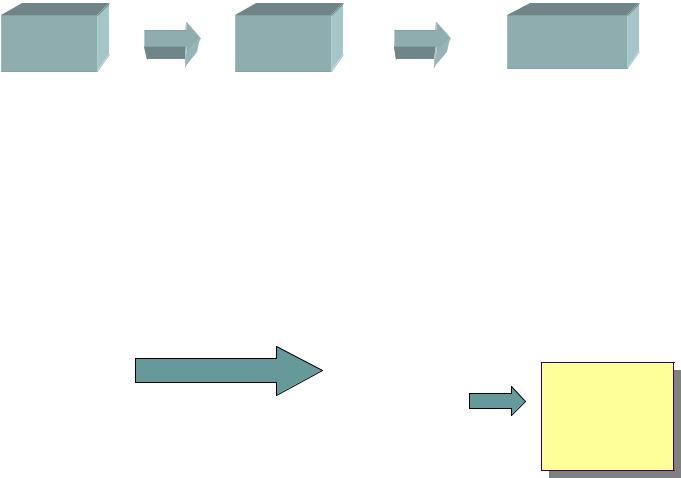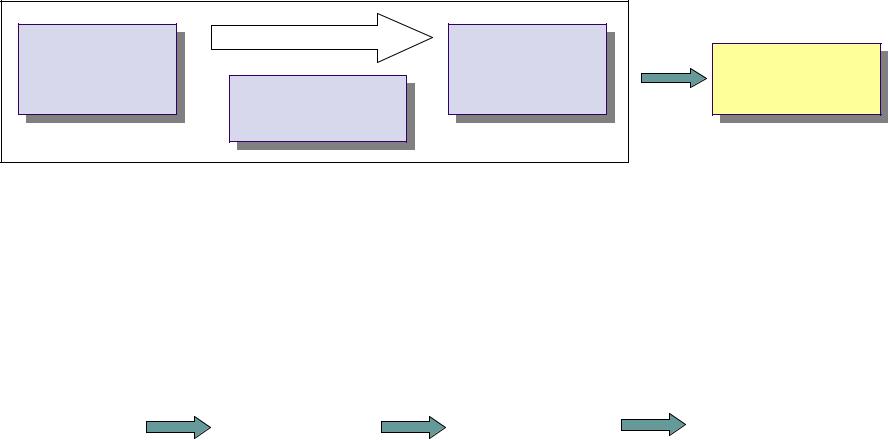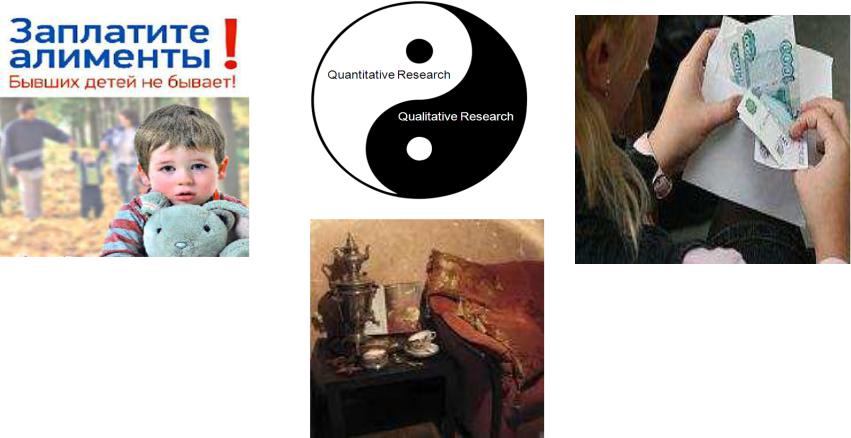
Gruber
.pdf
Types of Mixed Methods Designs (3)
3. Focus groups are first conducted. Information learned is then used to construct an instrument for a follow-up with a random sample.
QUAL |
QUAN |
RESULTS |
Exploratory Design
|
|
|
|
|
quan |
|
|
QUAL |
|
|
|
|
|
|
|
|
|
|
||
|
QUAL |
|
|
|
quan |
|
|
Data & |
|
|
|
Data & |
|
|
Data & |
|
|
|
Data & |
|
|
Results |
|
Building to |
|
Results |
|
|
Results |
|
|
Results |
|
|
|
|
|
|
|
|
|
|
|
|
|
|
|
|
|
|
|
|
|
|
|
Interpretation
Interpretation

Types of Mixed Methods Designs (4)
QUAN |
Intervention |
QUAN |
|
QUAN |
|
QUAN |
|
Pre-test Data & |
|
Post-test Data |
|
Pre-test Data & |
|
Post-test Data |
|
Results |
qual |
& Results |
Interpretation |
Results |
& Results |
Interpretation |
|
|
qual |
|
|
|
Process |
|
|
|
Process |
|
|
Sequential Embedded Design
|
|
|
|
|
QUAN |
|
|
|
|
|
|
|
|
|
|
|
|
|
|
|
|
|
|
|
|
|
|
|
|
|
Before- |
|
|
|
|
|
|
After- |
|
|
|
|
|
|
|
|
|
|
|
|
|
||||||||
|
Before- |
|
|
|
QUAN |
|
|
|
After- |
|
|
|
|
|
|
intervention |
|
|
|
Intervention |
|
|
|
intervention |
|
|
|
|
|
|
|
|
|
|
|
|
|
|
|
|
|
|||
|
intervention |
|
|
|
Intervention |
|
|
|
|
|
|
Interpretation |
|
|
|
qual |
|
|
|
Trial |
|
|
|
intervention |
|
|
|
|
|
|
|
|
|
Trial |
|
|
|
|
|
|
|
Interpretation |
|
|
|
qual |
|
|
|
|
|
|
qual |
|
|
|
|
||
|
|
|
|
|
|
|
|
|
|
|
|
|
||
|
|
|
|
|
|
|
|
|
qual |
|
|
|
|
|
|
|
|
|
|
|
|
|
|
|
|
|
|
|
|
|
|
|
|
|
|
|
|
|
|
|
|
|
|
|
|
|
|
|
|
|
|
|
|
|
|
|
|
|
|

Methodology and Methods: Combining
Qualitative and Quantitative Methods –
“Urban lone-mother households in Russia: The influe nce of risks and vulnerabilities on conducting a life“
(An Example of Mixed Methods Research)
Dr. Denis Gruber
DAAD-Lecturer
Saint Petersburg State University
Faculty of Sociology
E-Mail: dgspb@gmx.de
Strelna, St. Petersburg,
29.06.2012
Objects of Research
•How do lone-mother households in St. Petersburg, Ivanovo, Petrozavodsk and Novgorod cope with the challenges of the post-socialist period and a Russian-style market economy to have “security” in everyday life (strategies, muddling through, etc.)?
•What risks and vulnerabilities (shocks, trends and cri ses) do LMH have in Russia, if social security that was inherent in the Soviet welfare state system does not functioning anymore and/or has altered due to a shrinked role of the nation-state as the main provider of social security? (e.g. unemployment, wage arrears, black/grey/white salary payments, insurances, retirement planning, missing and/or wrong qualifications on the labour market, pension reforms etc.)?
•What kind of Lebensführung strategies do LMH pursue?
What to study?
•Gathering information on socio-demographic characteristics of femaleheaded households (household size, composition, location, sex, age, education, etc.);
•Examining social relations and networks developed among female-headed households and what kind of supports these relationships /networks do offer (family members, friends, neighbors, colleagues, acquaintances, etc.);
•Studying labor market positions of female-headed households in the formal and informal labor market (employment status, number of working places, looking for a job in the informal labor market, working hours, wages, wage losses due to crises, etc.);
•Scrutinizing household incomes and expenditures (lease rental charges; expenses for education, child care, etc.; credit lending and borrowing of money; savings and saving behavior);
•Estimations about satisfaction in life (life plans, personal situation, financial situation, motivations, etc.);
•Trust in and satisfaction with state services (education system, health system, support in the case of unemployment, security aspects, etc.);
•Perceptions about pension age (retirement planning, pension entitlements, etc.),
•Examining classes of insurances (life insurance, health insurance, etc.)
Subjects of Research
-cohorts between 30-45 years (year 2011)
-women in a capable age for occupation, but to be in a life stage in which at least thoughts about “retirement age" shal l play a role
-women occupied in the state sector (staff of universities and schools) and in „free economy“ (office management, sec retaries, book keeper, working in advertising companies, etc.)
-within this target group marriage, divorce and re-marriage behavior is one of the highest in Russia
-women who are mothers (child planning and raising) “double burden” of combining family (or better single parent 's family) and occupation; also relevant to ask for support achievements of the state and former partners/fathers of the children
-women who are at the same time „breadwinner“, head of household and main decission makers
Subjects of Research –city of origin and year of birth
year of birth |
St. Petersburg |
Iwanowo |
Veliky Nowgorod |
Petrozavod. |
total |
1966 |
10 |
1 |
6 |
4 |
21 |
1967 |
7 |
2 |
3 |
2 |
14 |
1968 |
12 |
2 |
6 |
4 |
24 |
1969 |
14 |
3 |
8 |
4 |
29 |
1970 |
17 |
7 |
5 |
7 |
36 |
1971 |
19 |
4 |
10 |
7 |
40 |
1972 |
29 |
12 |
13 |
10 |
64 |
1973 |
22 |
12 |
9 |
7 |
50 |
1974 |
28 |
10 |
2 |
5 |
45 |
1975 |
25 |
7 |
6 |
10 |
48 |
1976 |
30 |
4 |
8 |
2 |
44 |
1977 |
10 |
3 |
5 |
2 |
20 |
1978 |
13 |
6 |
3 |
4 |
26 |
1979 |
13 |
4 |
5 |
5 |
27 |
1980 |
12 |
8 |
3 |
7 |
30 |
1981 |
2 |
0 |
2 |
0 |
4 |
263 |
85 |
94 |
80 |
522 |
Subjects of Research –
city of origin and marital status
|
|
married, |
|
|
|
|
|
|
|
|
|
but |
|
never |
|
|
refused |
|
|
|
|
living |
|
being |
do not |
|
to |
|
|
|
widowed |
alone |
divorced |
married |
know |
|
answer |
|
total |
|
|
|
|
|
|
|
|
|
|
St. |
7 |
9 |
147 |
98 |
|
2 |
|
0 |
263 |
Petersburg |
|
|
|||||||
|
|
|
|
|
|
|
|
|
|
Iwanowo |
2 |
0 |
43 |
41 |
|
0 |
|
0 |
84 |
|
|
|
|
|
|
|
|
|
|
Veliky |
8 |
1 |
42 |
43 |
|
0 |
|
0 |
94 |
Nowgorod |
|
|
|||||||
|
|
|
|
|
|
|
|
|
|
Petroza- |
2 |
2 |
36 |
41 |
|
0 |
|
0 |
81 |
vodsk |
|
|
|||||||
|
|
|
|
|
|
|
|
|
|
total |
19 |
12 |
268 |
223 |
|
2 |
|
0 |
522 |
|
|
|
|
|
|
|
|
|
|
Research Design
-four Russian cities (St. Petersburg, Petrozavodsk, Ivanovo, Petrozavodsk)
-87 semi-structured guided interviews with women who belong to the target group
-12 interviews with experts (specific knowledge in science, politics, NGOs)
-quantitative data: online-questionnaire (522 women from St. Petersburg, Samara, Ivanovo, Petrozavodsk)
•ethnographic material: ethnographic interviews (not with respondents and experts): 6 interviews with two-adult households without children, 5 interviews with two-adult households with children, 7 interviews with women older than women of the target group), observations, field notices
•statistical data: Russian Longitudinal Monitoring Survey, demographic year books of Russia, All-Russian Census (2010)
•relevant secondary literature: gender studies, postsocialist transformation, FHH, Lebensführung
•data analysis: computer-based programmes (MAXQDA, SPSS)
further: combining quantitative and qualitative methods of research
Quantitative Research
Priorities
•having a representative sample and avoiding loss o f time elaborating a questionnaire online using ofb (online questionnaire) software with which it is possible to outline and upload surveys
•Pre-test checking content and improving the questionnaire
•No direct questions about income of respondents, b ut intervals
• |
Including answer categories: “do not answer”; “do not know” |
•Giving the questionnaire a logical flow and avoidi ng that participants lose interest dropout rate 578 : 522; 90,3 % (fully answered 113 questions); average 70 minutes
